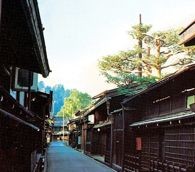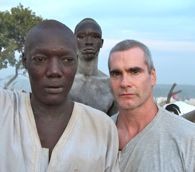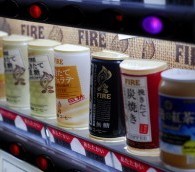Destination: Japan
Ramen: a ‘Steaming Bowl of Paradox’
by Pam Mandel | 08.26.14 | 9:36 AM ET
A flat of Top Ramen was essential gear during my “living out of a car for months on end” days. Prior to that, ramen was my college survival food of choice. It was cheap, easily supplemented with veggies, and required no complicated kitchen equipment. Ramen was what car campers and poor students ate, in quantity. Affordable, fast, uncomplicated. And, it turns out, culturally significant.
From Pacific Standard:
George Solt’s The Untold History of Ramen is an attempt to show how the dish—hot broth, wheat noodles, and (usually) pork—has become part of Japan’s identity and an international success. Ramen is a steaming bowl of paradox: a Chinese import now considered quintessentially Japanese both at home and abroad, and a workingman’s comfort food that has been refined into haute cuisine among the young and hip. Ramen shops have become a signature of the Japanese urban landscape. The country has over 35,000 of them, including at least four within a five-minute walk of my suburban Tokyo apartment.
Ramen is all the rage in the U.S., too. Ramen cookbooks are finding their way onto bookstore shelves and high-end ramen places are fast becoming as popular as the cheap Japanese noodle joints that crowd university neighborhoods. Eater, The New York Times, The Huffington Post and Buzzfeed have all run features on ramen’s hotness with the hip.
Of course, many people got their introduction to ramen from Cup Noodles. The humble Styrofoam cup now has its own museum in Yokohama, Japan, where you can trace its history and make your own takeaway serving of instant chicken ramen. From budget eats to museum souvenir—a fine illustration of ramen’s rags to riches glory.
And in case you’re wondering… warehouse pricing for a flat of Cup Noodles? About eight bucks.
Pico Iyer on Japan’s ‘Sadness That Will Not Go Away’
by Michael Yessis | 12.29.11 | 7:46 AM ET
Like Daisann McLane in her three-part series about Japan in the wake of its triple disaster, Pico Iyer has captured a haunting snapshot of life in the country post-earthquake and tsunami. He writes for Businessweek:
When I went up to the area around the nuclear plant in October, I found myself staying in, of all places, a golf resort by the sea. Many of the locals had left the area after the disaster, I was told. When I arrived, late at night, the big hotel looked like a ghost town. Only a handful of kimono-clad guests seemed to be enjoying the tea lounge and the play area.
Next morning, I awoke early and went into the breakfast room at 6:15—to find every table packed. Dapper golfers from Tokyo were busy scarfing down their eggs, about to head out for their first round, undeterred by pelting rain and the belching factories that surround the seaside course. In some places this could look like recklessness or indifference; in Japan it seemed to stand for fortitude.
(Via @gary_singh)
Journey to High Mountain
by Tara Austen Weaver | 12.13.11 | 12:36 PM ET
In an e-book excerpt, Tara Austen Weaver finds a new home in rural Japan
Interview with Henry Rollins: Punk Rock World Traveler
by Jim Benning | 11.02.11 | 12:40 PM ET
Jim Benning asks the musician about his new book of photographs and how travel has humbled him
Pico Iyer: The Japanese ‘Have More Resolve and Fortitude Than Almost Anyone I’ve Seen’
by Jim Benning | 03.15.11 | 12:38 PM ET
Like everyone, I’ve been horrified by the news out of Japan following the earthquake, tsunami and nuclear power plant explosions. Among other things, I’ve been wondering how author and World Hum contributor Pico Iyer is doing, and whether he has been home in Japan or traveling as the disaster unfolds.
I just heard from him via email:
By curious chance, and with rare good timing, I actually flew out of Japan last Thursday night, hours before the earth began to move, and so I’m just sitting in placid Santa Barbara now, where nothing seems to move at all. But everyone I know in Japan sounds fine, and is going about her life as usual, for now at least a safe distance from all the horror.
He added:
Let’s hope the Japanese, who have more resolve and fortitude than almost anyone I’ve seen, can put their land together again very soon.
Let’s hope.
How to Drink Like a Japanese Salaryman
by Amy McKeever | 02.09.11 | 1:52 PM ET
Amy McKeever explains how to navigate an epic night of beer, yakitori and "nomunication"
‘Hello Kitty’ Gets a Theme Park of Her Own
by Eva Holland | 10.26.10 | 11:33 AM ET
The new park, Hello Kitty Kawaii Paradise opened late last week in Tokyo. “Hello Kitty” creator Sanrio already had two theme parks devoted to Kitty and her friends, but Gadling blogger Leigh Caldwell notes that this is the first one where the famous cartoon cat flies solo on the marquee. So congrats, Hello Kitty, on having top billing all to yourself.
Paris Hilton Channels Paul McCartney in Japan
by Eva Holland | 09.22.10 | 5:15 PM ET
Yep, the heiress followed in some famous footsteps today when she was denied entry to Japan because of a U.S. drug conviction.
As Gawker’s Jeff Neumann points out, she’s now a member of a rather elite travel club: “She joins Wings-era Paul McCartney and the Rolling Stones on Japan’s list of druggie deportees.”
I hope she enjoys the moment—judging by this music video, she won’t likely see her name alongside McCartney’s and Jagger’s again anytime soon.
Interview with Michael Scott Moore: ‘Sweetness and Blood’
by Jim Benning | 09.08.10 | 12:32 PM ET
Jim Benning talks with the author of a new travel book about the spread of surfing around the globe
Venezuelans Show Some Love For Love Hotels
by Michael Yessis | 08.17.10 | 11:25 AM ET
Japan’s love hotels get a lot of media love. Now it’s Venezuela’s turn in the spotlight. Rachel Jones writes:
University students such as Daniel Ramirez, 24, often turn to mid-range hotels in central Caracas to be with their significant others. On his first visit to Hotel Roda, Ramirez had the opportunity to be intimate with a month-long girlfriend for the first time.
“There was no place I could go to see her,” said Ramirez, who lives with his family because he can’t afford an apartment. He was reasonably satisfied with his experience—including clean rooms, wall and ceiling mirrors, and a television with pornography—and later returned with another girlfriend. The awkward part, he said, was a lack of privacy in the hallways.
“Couples pass each other like this,” Ramirez said, ducking his head and cupping one hand over his eyes.
Roger Ebert on ‘Lost in Translation’
by Jim Benning | 08.10.10 | 12:28 PM ET
I’ve never read a more insightful piece about the beauty and nuance in Sofia Coppola’s “Lost in Translation”—a masterpiece of a film—than this one. Coppola has one objective, Ebert writes:
She wants to show two people lonely in vast foreign Tokyo and coming to the mutual realization that their lives are stuck. Perhaps what they’re looking for is the same thing I’ve heard we seek in marriage: A witness. Coppola wants to get that note right. There isn’t a viewer who doesn’t expect Bob Harris and Charlotte (Scarlett Johansson) to end up in love, or having sex, or whatever. We’ve met Charlotte’s husband John (Giovanni Ribisi). We expect him to return unexpectedly from his photo shoot and surprise them together. These expectations have been sculpted, one chip of Hollywood’s chisel after another, in tens of thousands of films. The last thing we expect is… what would probably actually happen. They share loneliness.
Among other highlights, Ebert explains why he can’t take his eyes off of Bob Harris (Bill Murray) in the film, and why whatever Johansson’s character whispers into Bob’s ear at the end simply doesn’t matter. (Via LAObserved)
Confessions of a Focus Group Traveler
by LiAnne Yu | 06.08.10 | 11:14 AM ET
When LiAnne Yu visits other countries, she watches people from behind a one-way mirror. She now knows which cultures prefer jeans that accentuate curvy butts.
Photos: Tokyo Taxi Tops
by Michael Yessis | 05.26.10 | 2:24 PM ET
Alexander James shares 50 of them in the Los Angeles Times Magazine. The tops feature, among other things, dogs, frogs and what appears to be a neon green football—see No. 17. (Via Coudal)
Seven Breakfasts Every World Traveler Must Eat
by Terry Ward | 05.20.10 | 11:57 AM ET
Petit dejeuner, frühstück, desayuno -- call it what you will. Terry Ward dishes on some of the world's great breakfasts.
See the full photo slideshow »
Video You Must See: Japan at Warp Speed
by Eva Holland | 05.18.10 | 1:10 PM ET
An up-tempo time-lapse visit to Japan
- « Prev Page
- Next Page »







